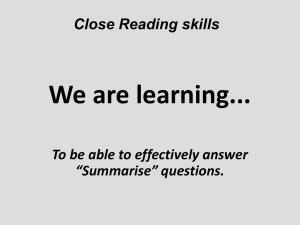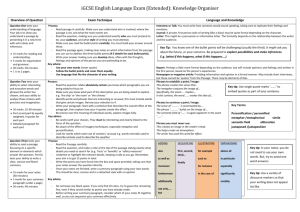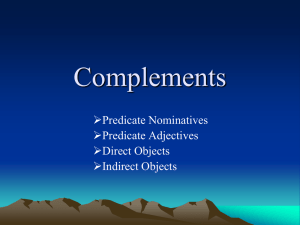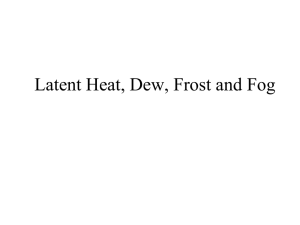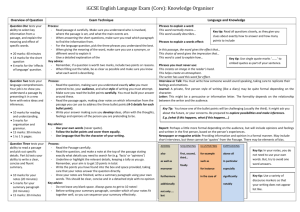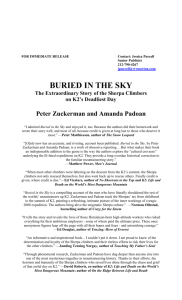2015 Spec PPE IGCSE style Extended Paper Everest Mark Scheme
advertisement
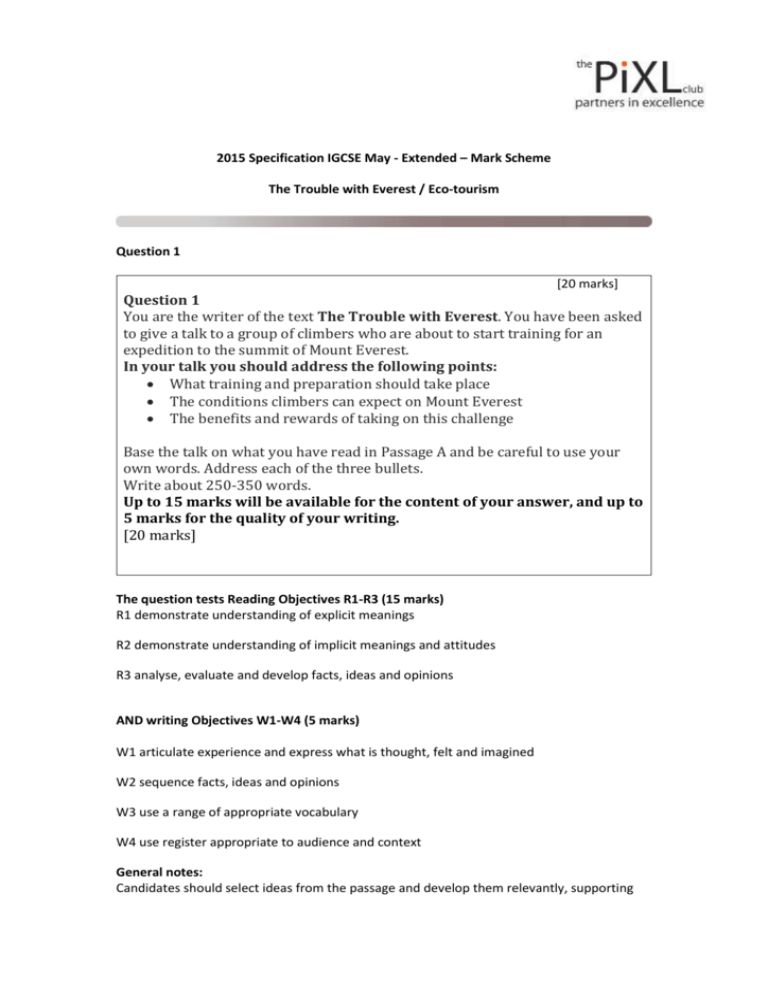
2015 Specification IGCSE May - Extended – Mark Scheme The Trouble with Everest / Eco-tourism Question 1 [20 marks] Question 1 You are the writer of the text The Trouble with Everest. You have been asked to give a talk to a group of climbers who are about to start training for an expedition to the summit of Mount Everest. In your talk you should address the following points: What training and preparation should take place The conditions climbers can expect on Mount Everest The benefits and rewards of taking on this challenge Base the talk on what you have read in Passage A and be careful to use your own words. Address each of the three bullets. Write about 250-350 words. Up to 15 marks will be available for the content of your answer, and up to 5 marks for the quality of your writing. [20 marks] The question tests Reading Objectives R1-R3 (15 marks) R1 demonstrate understanding of explicit meanings R2 demonstrate understanding of implicit meanings and attitudes R3 analyse, evaluate and develop facts, ideas and opinions AND writing Objectives W1-W4 (5 marks) W1 articulate experience and express what is thought, felt and imagined W2 sequence facts, ideas and opinions W3 use a range of appropriate vocabulary W4 use register appropriate to audience and context General notes: Candidates should select ideas from the passage and develop them relevantly, supporting what they write with details from the passage. Look for an appropriate register for the genre, and a clear and balanced response which covers the three areas of the question, is well sequenced, and is in the candidate’s own words. Candidates might use the following ideas What training and preparation should take place • • • • • • • • • Climbing other mountains Climbing in similar conditions i.e. snow and ice Purchase/acquisition of appropriate equipment to high specification Physical training to improve fitness Climbing at altitude so that the body can be accustomed to lower levels of oxygen Costings /financial planning Planning a route Ensuring you have a guide Contingency plan for unexpected events or accidents The conditions climbers can expect on Everest Snow and blizzards Difficult/inhospitable terrain Dangerous cracks in glacial ice Sudden and unexpected changes in weather conditions Extreme conditions such as freezing fog Altitude sickness/oxygen deprivation Freeing/sub-zero temperatures Very powerful winds The benefits and rewards of taking on this challenge Sense of personal achievement Improved physical fitness and health Status of being someone who has climbed Everest Seeing natural beauty at its best Developing high levels of resilience Working as part of a team The discriminator is the development of the writer’s opinions and predictions for the future, as this requires candidates to draw inferences. Ideas and opinions must be derived from the passage, developing the implications. A CONTENT (Extended Tier) Use the following table to give a mark out of 15 for Reading B WRITING: STRUCTURE AND ORDER, STYLE OF LANGUAGE Use the following table to give a mark out of 5 for Writing. Question 2 Question 2 Re-read the descriptions of: (a) The fog in paragraph 3 , beginning, “On Everest the weather can change… ” (b) The climate in paragraph 4, beginning, “But fog is not the only hazard…” Select four powerful words or phrases from each paragraph. Your choices should include imagery. Explain how each word or phrase selected is used effectively in context. Write about 200 to 300 words. Up to 10 marks are available for the content of your answer. This question tests Reading Objective R4 (10 marks) R4 – demonstrate understanding of how writers achieve effects (a) The fog in paragraph 3, beginning, “On Everest the weather can change… ” The general effect is that the fog is both overpowering and dangerous. “impenetrable “ – the fog is so dense climbers cannot see or move through it “living, breathing ghostly white matter” – the personification of the fog suggests that it is like a living ghost, making climbers fearful of its power “suffocating mist” – the fog almost chokes the climbers because it is so thick “white blindfold” - the fog blinds the climbers, emphasising the dangers they face because they cannot see “a web of entrapment” – the fog can make climbers feel as they have been caught in a maze because they do not know which way to go; the fog is deliberately trying to trap them (b) The climate in paragraph 4, “But fog is not the only hazard…” The general effect suggests that the climate, including the wind, is very severe and powerful. “Laced with ice” – the temperatures are always cold; it is as if nature is being deliberately destructive/violent by poisoning/spiking the air with freezing conditions “persistent, violent force” – the temperatures do not get any better; they are constantly challenging for the climbers “aggressive and punishing bite” – personification of the climate; the climate is like an angry and violent person; it makes climbers feel intimidated, as if the climate is causing them harm for daring to try and conquer Everest “blinding and perilous blizzard conditions” - the blizzards are so severe that the climbers are left vulnerable because they cannot see. “Perilous” shows that the blizzards are extremely dangerous, to the point where human life is threatened. “Furious, hurricane level wind” – emphasises the power and strength of the wind; the personification of the wind shows that it is reacting as if it is extremely angry Reading: Language Analysis Use the following table to give a mark out of 10 for Reading Question 3 This question tests Reading Objectives R1, R2 and R5 (15 marks): R1 demonstrate understanding of explicit meanings R2 demonstrate understanding of implicit meanings and attitudes R5 select for specific purposes and writing assessment objectives W1 to W3 (5 marks) W1 articulate experience and express what is thought, felt and imagined W2 sequence facts, ideas and opinions W3 use a range of appropriate vocabulary (a) Notes What opportunities and benefits does eco-tourism offer, according to Passage B? Write your answer using short notes. You do not need to use your own words. Up to 15 marks are available for the content of your answer. Reading content for Question 3 (a) Give 1 mark per point listed below, up to a maximum of 15 The opportunities and benefits offered by Eco-Tourism in Passage B Give 1 mark for a point about: 1. 2. 3. 4. 5. 6. 7. 8. 9. 10. 11. 12. 13. 14. 15. 16. 17. Chance to travel to faraway/exotic locations Work with wildlife such as orang utans in Borneo/orphan elephants in Africa Practical tasks such as digging a well in Indonesia Increased amounts of money going into ecological and wildlife projects Satisfying the human need to help Appeals to our desire to champion a cause Doing something that fulfills a moral purpose Makes you feel less guilty about the damage to the environment Helps communities create resources and facilities that will provide long-term help Can help a wide range of people in local and international destinations Helps communities make money Improves social mobility Provides more opportunities for trade and tourism Makes a difference to the planet. Allows you to participate in and learn about different cultures/ways of life Preserves traditions and methods Improves human rights for vulnerable communities through raising awareness 18. Brings about change that will make a difference to other people in the future Note: Although lifting of words and phrases from the passage is acceptable it is important that in such cases candidates show evidence of understanding by clearly focusing on the key details; over-lengthy lifting which does not identify specific points should not be rewarded. Credit responses that attempt to use own words and convey the essence of the point. (b) Now use your notes to write a summary of what Passage B tells you about the opportunities and benefits of eco-tourism. You must use continuous writing (not note form) and use your own words as far as possible. Your summary should include all 15 of your points in Question 3(a) and must be 200 to 250 words. Up to 5 marks are available for the quality of your writing. Marking Criteria for Question 3 (b) Writing: (concision, focus and use of own words) Use the following table to give a mark out of 5 for Writing. PiXL has written both the papers, and the ‘answers’ provided in this Mark Scheme. The instructions on how to mark the paper, including objectives and the marking grids, are taken from the CIE Mark Scheme.

